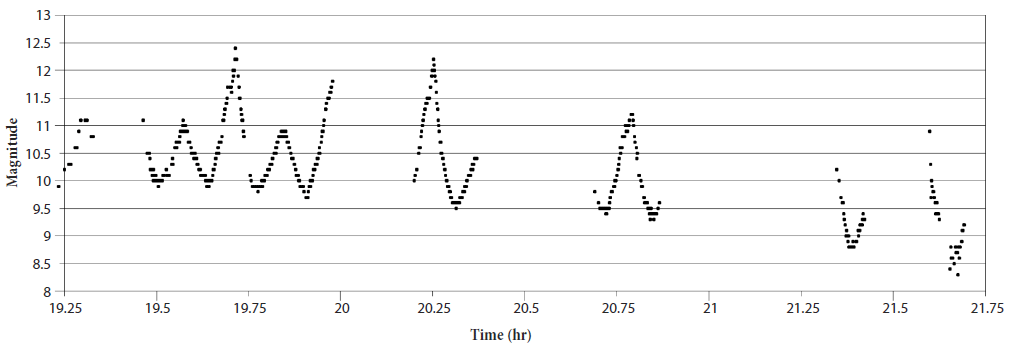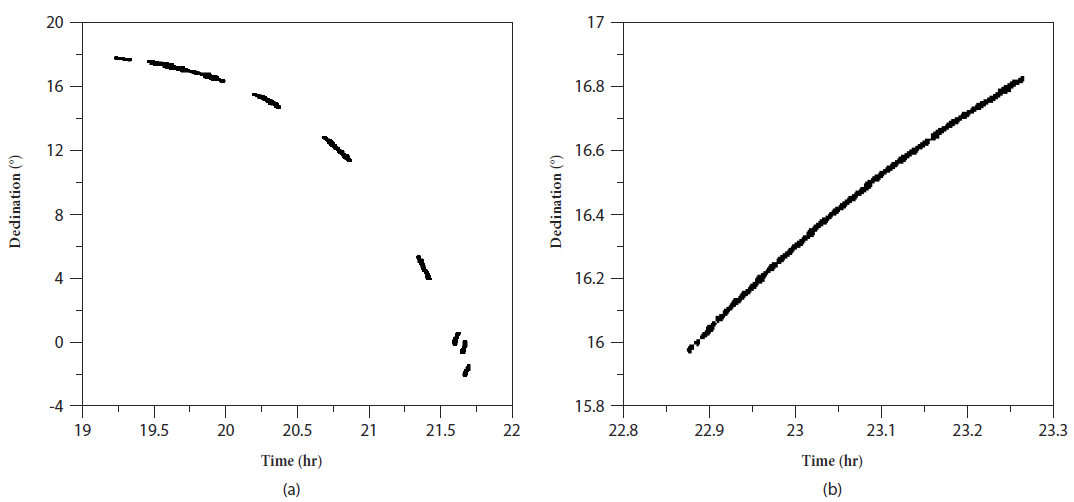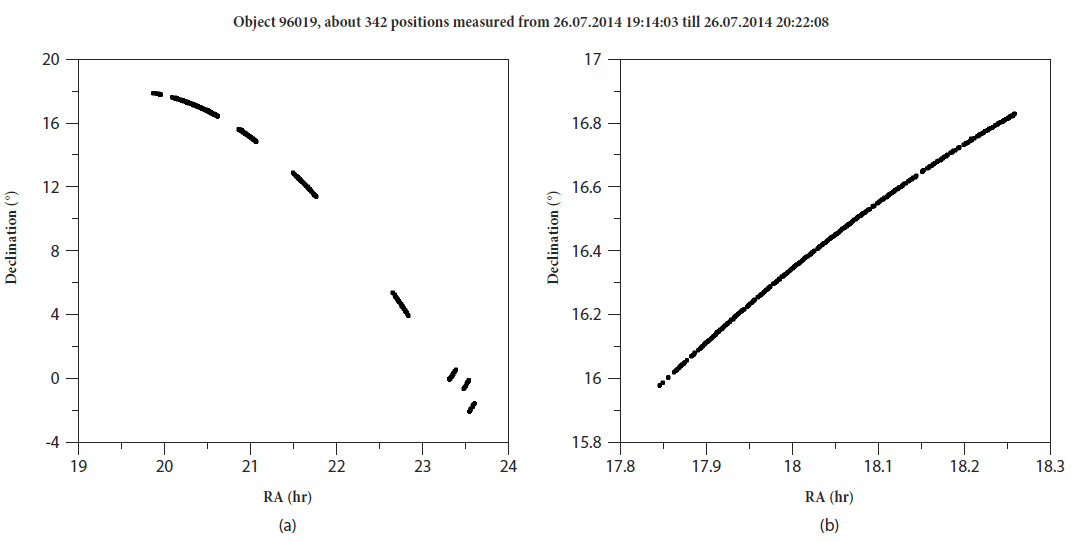1. INTRODUCTION
Satellites that have completed their missions are called space debris. The positions of such debris can be tracked through observations. An algorithm for estimating a satellite’s rotational parameters has been developed to investigate and identify debris and satellites in near-Earth space (Pavlenko 2012). Color and photometric signatures are used to determine the identities and characteristics of satellites, which is differentiated by type of satellite (Payne et al. 2007). In addition, because different satellites have different brightnesses, optical photometric observations provide information about a satellite’s position, attitude and material properties (Jah & Madler 2007;Hall 2010). Moreover, optical observation is an important method for empirical interpretation and determining the shapes of asteroids (Schildknecht et al. 2008;Seo et al. 2013). Optical surveys primarily provide statistical information about the environment, including rough characterization of the orbits and brightnesses (magnitude, unit: [m]) of objects. Variations of light are useful for detecting the relative positions and characteristics of space objects and debris. However, conversion of magnitude data to physical size data requires detailed information about the surface properties and shapes of the objects in question. Analysis of these properties requires observations of individual objects with large aperture telescopes with narrow fields of view to obtain light curves or spectra. Other physical characteristics, such as the area-to-mass ratio (AMR), can be derived by monitoring the orbits over long time intervals (Cognion 2013;Levkina et al. 2013;Selim et al. 2016).
In this research, the physical and orbital characteristics of small space object 96019 are studied; both photometric and optical measurements are used to investigate these properties. Tasks and mission of observations are given, and the observational data are provided. The results are analyzed, and the conclusions formulated based on these results are discussed.
2. OBSERVATIONS AND RESULTS
The Zvenigorod Observatory is an optical satellite tracking station. A wide-angle Hamilton’s camera and Santel-500 telescope with a charge-coupled device (CCD) camera model FLI PL9000 is used for observation at this station. Ground-based photometric observations are used for measurement and tracking of objects. At this facility, sensitive CCD cameras are used as image sensors. Observations are performed using global positioning system (GPS)-timing system and the APEX software package for CCD frame processing and camera control, which was developed at the Pulkovo Observatory of the Russian Academy of Sciences (Rusakov & Kouprianov 2007;Kouprianov 2008). Based on optical surveys covering the sky several times per night and observations carried out using this telescope, the object 96019 was detected during the tracking process of new objects with high brightness variability. Collected data from networked sensors were sent to an integration center for analysis to determine the orbit of the detected object using specific software tools. The position data and parameters of this object were improved and used to determine the orbit of the object, and thus to determine the AMR. The parameters of the Santel-500 telescope are given in Table 1 (Bakhtigaraev 2010).
The observation tasks performed at this station include the discovery and detection of new space objects, as well as the important task of tracking all objects with high brightness. In addition, photometric observations of small objects and debris and detection of their orbital parameters are performed and taken into consideration.
We received a short series of positional measurement of the object number 96019 (numbered according to the ballistic center dynamic database of Keldysh Institute for Applied Mathematics (KIAM) of Russian Academy of Sciences, which maintains a catalog of space objects) from the Zvenigorod Observatory collected from July to October 2014. The dynamic base North American Aerospace Defense Command (NORAD) this object is missing data. This object is drawn in an orbit with a high value of eccentricity. According to the division of satellites operating in geosynchronous orbit, this value is considered to be intermediate. Object movement parameters are improved based on observations carried out at the Zvenigorod Observatory over two days. Estimates for six orbital elements and two med ratios of the AMR of the object are calculated. The first value, (A/m)r, accounts for the effective reflection coefficient, and the second value, (A/m)b, accounts for the ballistic coefficient (m2/kg). Amendments to these parameters for two-day intervals for the month of August were not calculated. Estimates for certain parameters are shown in Table 2. The column "shine" gives the average value of the brightness in this range.
Observations of the object 96019 were made in July 2014. In this analysis, observations from two days (July 26 and 28, 2014) were analyzed to verify the variations and properties of the object over the observation interval. During the night of July 26, 2014, approximately 342 positions were measured. Fig. 1 shows the graph of light curve that shows the brightness of the object over the period of time based on observational data for July 26, 2014. This figure shows significant variations over the observation period. It is noteworthy that this object has been brightened by three magnitudes over 3 minutes. The fluctuation shown in the light curve indicates a maximum brightness of about 12.4 magnitudes with an average brightness value, or shine, of about 10.2m over the observation period, as given in Table 2. The conditions and phase behavior that describe the status and tracking of this object during this night over the period of observation are shown in Fig. 2.

The light curves express quasi-periodic signals, and bright small objects with low AMRs show periods of several minutes. Large amplitudes (peak-to-peak) are found among these objects. Moreover, note that the behavior of these bright objects may show considerable differences in light curves over time. The light curve of this object obtained on July 26, 2014, for all intervals of time is shown in Fig. 3.

Additional observations can be used to investigate the physical characteristics of this object, particularly its size, shape, attitude states, and material type. Observation techniques such as light curves may be used to characterize objects and determine their shapes and attitude motions. Therefore, Fig. 4 describes changes in the brightness of the object observed on July 28, 2014 for all time intervals. This figure shows that the light curve reflects a quasi-sinusoidal curve. This type of light curve can be obtained as a result of observing a free tumbling object. The behavior of the light curves shown in Figs. 3 and 4 roughly indicate that the object is rotating or tumbling at a considerably high rate. We also infer that this object is likely to be asymmetric in shape.
3. DISCUSSION AND DATA ANALYSIS
From the observed data collected on July 26 and 28, 2014, the variations in right ascension and declination for this object for all time intervals are demonstrated as follows: Fig. 5 shows the variation of the declination over time during the observations taken on July 26 (Fig. 5(a)) and July 28 (Fig. 5 (b)). As shown in Fig. 5(a), a gradual decrease in declination is observed, followed by a rapid drop near the end of the observational period. In contrast, as shown in Fig. 5(b), the declination shows different behavior with a continuous increase until the end of the observational period.

Variations in the declination with right ascension were obtained and plotted in Figs. 6(a) and 6(b) based on the observed data from July 26 (Fig. 6(a)), and from July 28 (Fig. 6(b)), 2014, respectively. Different behaviors are observed in these two charts. On July 26, the declination decreased with the right ascension, whereas on July 28, it was observed that the declination increased over all time intervals. These figures show change in the location of the object with a rapid decline over the two days of observations.

Magnitudes and their variations can be used to estimate the sizes and attitude changes of objects. However, conversion of magnitude to physical size requires detailed information about the surface properties and the shape of an object. Sequences of brightness measurements over time (i.e., a light curve) may give an indication of this object’s shape and its tumbling or rotation rate. Measuring the period between maxima/ minima in the light curve yields a good approximation of a satellite's rotational motion. However, some objects show distinct signatures and periods in their light curves. These features seem to be stable over long periods of time and may be used to identify such objects. Other objects show highly variable light curves with considerable changes in amplitudes and periods, which indicate complex shapes and scattering properties.
4. CONCLUSION
Light curves for the space object 96019 were obtained for different spans of time. The measurements of these light curves show a wide variety of signatures and give brightness raised from the lower to the maximum one by three magnitude (3m). Highly variable light curves with changing amplitudes and periods are observed. The peak in brightness is approximately 12.4m, with an average value of 10.2m. Light curve measurements and periodic changes in brightness give an indication of the attitude of motion and shape of an object and may help detect abnormalities of satellites. The light curve of this object is found to reflect a quasi-sinusoidal curve, which is observed for a free tumbling object. However, the variation of the declination over time shows opposite behavior between the two days of the observations. Evaluation of the light curves can be helpful in determining the attitude state of the object, which is important for determining the correct time varying area-to-mass value, and enables more accurate state predictions, and also can assist with long-term tracking and orbit determination of the object.
Finally, it can be concluded that reliable parameters of the translational motion of the object 96019 can be obtained based on the observational data for two days. These parameters and the results of qualitative analysis of the variations in brightness comprise a suitable basis for the simulation of rotational motion. As a first approximation, these data can be used to model an object as a cylinder rotating in the orbital plane. The characteristics of small space object debris may also help to identify the predominant sources of debris at different orbital altitudes.



